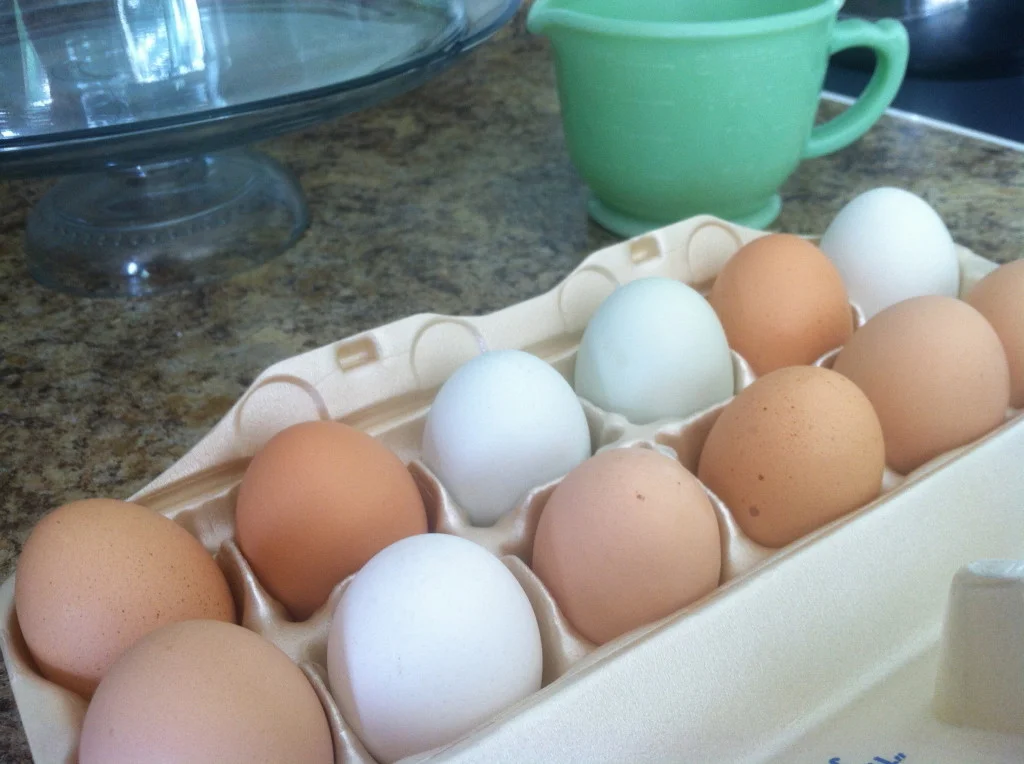What makes eggs different colors?
Note: This post was updated on July 1, 2017. Monnett Farms no longer raises chickens or sells eggs - but we know some awesome farmers who do. Check out Swamp Fox Farm or Battle Creek Beef if you're interested in buying local eggs. Both farms sell along side us at the California BAE Farmers Market in Lexington Park.
When we were raising eggs, a lot of people would ask, “why do the eggs come in different colors?” Basically, it comes down to genetics. Some chicken breeds lay brown eggs, some white and some blue. But that doesn’t really answer the question, so we went on the hunt to learn more.
Monnett Farms chickens would produce white, brown and blue colored eggs.
One answer you’ll read is that the color of the feathers indicates the color of the egg shell. While there may be some loose correlation, it certainly isn’t true that white feathers mean white eggs and brown feathers mean brown eggs.
Our Barred Rock Chickens have black and white feathers and lay brown eggs.
We also had a Brahma Chicken with white feathers who laid brown eggs.
The Buff Laced Polish Chickens have light brown feathers and produce white eggs.
Ameraucana Chickens, (aka “Easter Eggers”) have dark brown feathers and lay blue-green eggs.
CHICKENS HAVE EARLOBES?
More so than feather color, it is actually the color of the earlobes — sounds silly, but most chickens have earlobes — that will indicate shell color. Chickens with white earlobes generally lay white eggs, while chicken with red earlobes lay brown eggs.
There are some indications that there may also be a correlation between the origin of the species and the egg shell color. Mostly speaking, chickens of Asian descent lay brown eggs, Mediterranean chickens lay white eggs and South American chickens lay blue/green eggs.
THE SCIENCE BEHIND SHELL COLOR
How egg shells gets their color involves a biology and chemistry lesson, but we’ll try and keep things light here. It takes 26 hours for a hen to produce an egg. Twenty of those hours are required to form the shell. Near the end of this process, some hens will release a pigment that colors the shell.
These pigments are called porphyrins and they influence color in nearly everything from plants to human blood. Concentrations of protoporphyrin result in brown eggs, while biliverdin will produce a blue or green hued egg.
Interestingly enough, a study was recently published by the University of Nottingham School of Biology that illuminated the origin of the blue-green eggs. In the study, researchers found that an ancient virus in native South American chickens resulted in a genetic mutation that triggered an accumulation of biliverdin, causing the chickens to produce blue/green eggs.
AN EGG IS AN EGG
So, what do the different egg colors mean? Well, nothing.
Aside from the fact that their shells are different colors, all eggs are virtually the same. There is a greater difference in eggs based on the chicken’s diet and how it was raised.





